There be 句型和have句型,情态动词can(讲解与练习)
- 格式:doc
- 大小:30.00 KB
- 文档页数:2
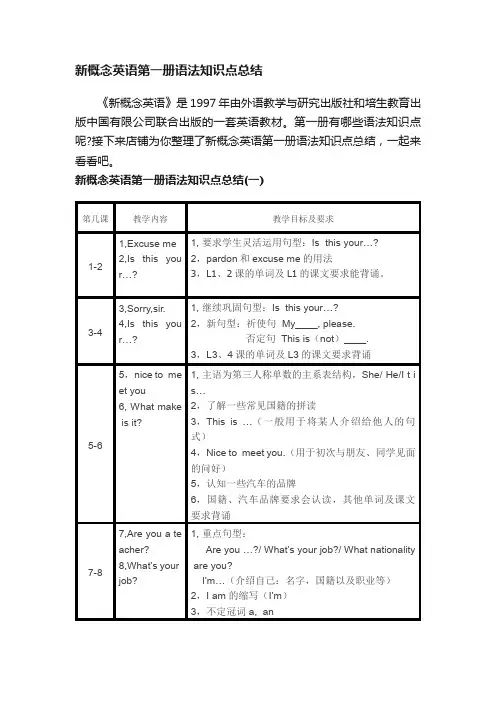
新概念英语第一册语法知识点总结《新概念英语》是1997年由外语教学与研究出版社和培生教育出版中国有限公司联合出版的一套英语教材。
第一册有哪些语法知识点呢?接下来店铺为你整理了新概念英语第一册语法知识点总结,一起来看看吧。
新概念英语第一册语法知识点总结(一)第几课教学内容教学目标及要求1-21,Excuse me2,Is this your…?1,要求学生灵活运用句型:Is this your…?2,pardon和excuse me的用法3,L1、2课的单词及L1的课文要求能背诵。
3-43,Sorry,sir.4,Is this your…?1,继续巩固句型:Is this your…?2,新句型:祈使句 My____, please.否定句 This is(not)____.3,L3、4课的单词及L3的课文要求背诵5-65,nice to meet you6, What makeis it?1,主语为第三人称单数的主系表结构,She/ He/I t is…2,了解一些常见国籍的拼读3,This is …(一般用于将某人介绍给他人的句式)4,Nice to meet you.(用于初次与朋友、同学见面的问好)5,认知一些汽车的品牌6,国籍、汽车品牌要求会认读,其他单词及课文要求背诵7-87,Are you a teacher?8,What’s yourjob?1,重点句型:Are you …?/ What’s your job?/ What nationality are you?I’m…(介绍自己:名字,国籍以及职业等)2,I am的缩写(I’m)3,不定冠词a, an9-109, How are you today?10, Look at…1,重点句型:How are you?(朋友或相识的人之间见面时的寒暄话)2,如何问候他人(How is …?)3,nice to see you .(见面时的客气话)4,Look at…(看…)。
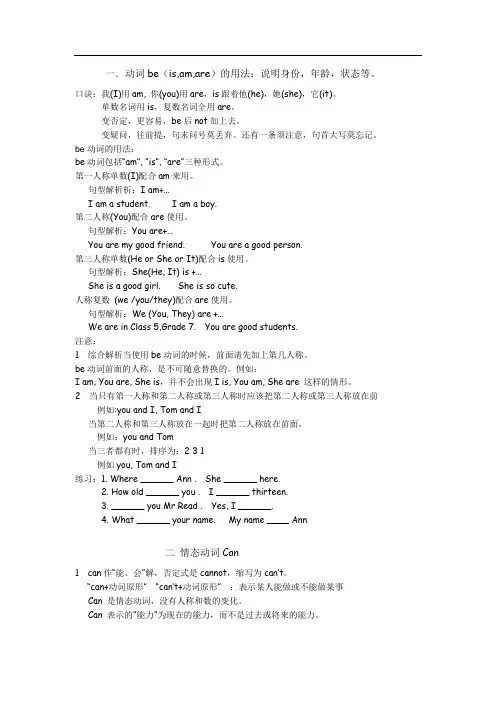
一.动词be(is,am,are)的用法:说明身份,年龄,状态等。
口诀:我(I)用am, 你(you)用are,is跟着他(he),她(she),它(it)。
单数名词用is,复数名词全用are。
变否定,更容易,be后not加上去。
变疑问,往前提,句末问号莫丢弃。
还有一条须注意,句首大写莫忘记。
be动词的用法:be动词包括“am”, “is”, “are”三种形式。
第一人称单数(I)配合am来用。
句型解析析:I am+…I am a student. I am a boy.第二人称(You)配合are使用。
句型解析:You are+…You are my good friend. You are a good person.第三人称单数(He or She or It)配合is使用。
句型解析:She(He, It) is +…She is a good girl. She is so cute.人称复数(we /you/they)配合are使用。
句型解析:We (You, They) are +…We are in Class 5,Grade 7. You are good students.注意:1 综合解析当使用be动词的时候,前面请先加上第几人称。
be动词前面的人称,是不可随意替换的。
例如:I am, You are, She is,并不会出现I is, You am, She are 这样的情形。
2 当只有第一人称和第二人称或第三人称时应该把第二人称或第三人称放在前例如:you and I, Tom and I当第二人称和第三人称放在一起时把第二人称放在前面,例如:you and Tom当三者都有时,排序为:2 3 1例如you, Tom and I练习:1. Where ______ Ann . She ______ here.2. How old ______ you . I ______ thirteen.3. ______ you Mr Read . Yes, I ______.4. What ______ your name. My name ____ Ann二情态动词Can1 can作“能、会”解,否定式是cannot,缩写为can’t。
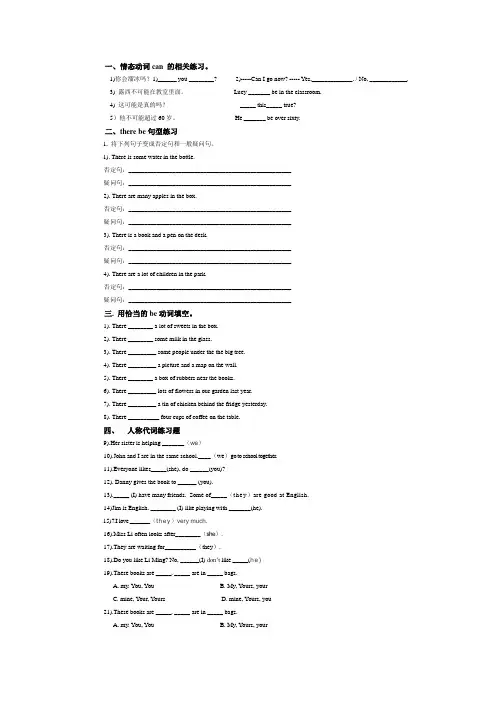
一、情态动词can 的相关练习。
1)你会溜冰吗?1)______ you ________? 2)-----Can I go now? ----- Yes,_____________. / No, ____________.3) 露西不可能在教室里面。
Lucy _______ be in the classroom.4) 这可能是真的吗?_____ this_____ true?5)他不可能超过60岁。
He _______ be over sixty.二、there be句型练习1. 将下列句子变成否定句和一般疑问句。
1). There is some water in the bottle.否定句:____________________________________________________疑问句:____________________________________________________2). There are many apples in the box.否定句:____________________________________________________疑问句:____________________________________________________3). There is a book and a pen on the desk.否定句:____________________________________________________疑问句:____________________________________________________4). There are a lot of children in the park.否定句:____________________________________________________疑问句:____________________________________________________三. 用恰当的be动词填空。
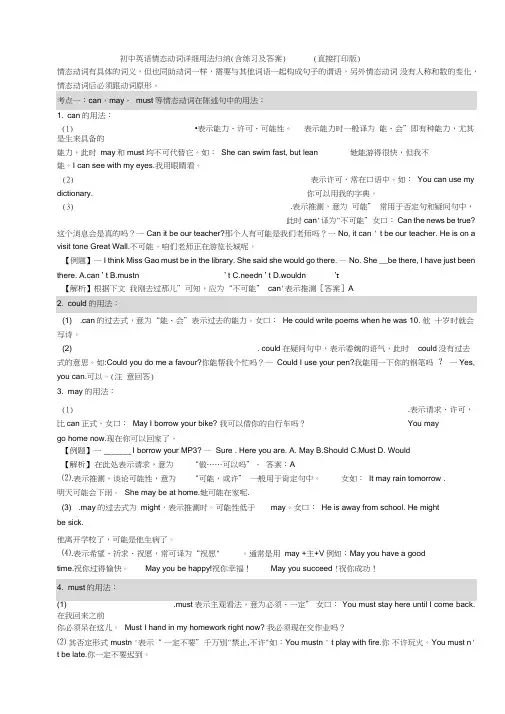
初中英语情态动词详细用法归纳(含练习及答案) (直接打印版)情态动词有具体的词义,但也同助动词一样,需要与其他词语一起构成句子的谓语,另外情态动词没有人称和数的变化,情态动词后必须跟动词原形。
1. can的用法:(1)•表示能力、许可、可能性。
表示能力时一般译为能、会”即有种能力,尤其是生来具备的能力,此时may和must均不可代替它。
如:She can swim fast, but lean 她能游得很快,但我不能。
I can see with my eyes.我用眼睛看。
(2)表示许可,常在口语中。
如:You can use my dictionary. 你可以用我的字典。
(3).表示推测,意为可能” 常用于否定句和疑问句中,此时can'译为"不可能”女口:Can the news be true?这个消息会是真的吗?一Can it be our teacher?那个人有可能是我们老师吗?一No, it can ' t be our teacher. He is on a visit tone Great Wall.不可能。
咱们老师正在游览长城呢。
【例题】一I think Miss Gao must be in the library. She said she would go there. —No. She __be there, I have just beenthere. A.can ' t B.mustn ' t C.needn ' t D.wouldn 't【解析】根据下文我刚去过那儿”可知,应为“不可能” can'表示推测[答案]A(1) .can的过去式,意为“能、会”表示过去的能力。
女口:He could write poems when he was 10. 他十岁时就会写诗。
(2) . could在疑问句中,表示委婉的语气,此时could没有过去式的意思。
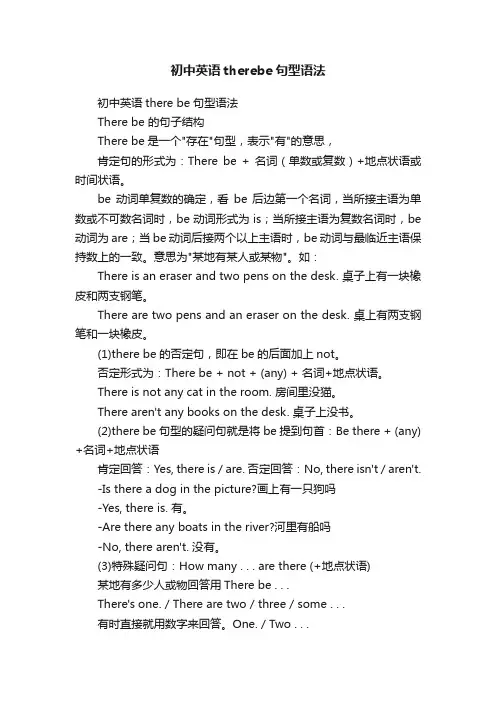
初中英语therebe句型语法初中英语there be句型语法There be 的句子结构There be是一个"存在"句型,表示"有"的意思,肯定句的形式为:There be + 名词(单数或复数)+地点状语或时间状语。
be动词单复数的确定,看be后边第一个名词,当所接主语为单数或不可数名词时,be动词形式为is;当所接主语为复数名词时,be 动词为are;当be动词后接两个以上主语时,be动词与最临近主语保持数上的一致。
意思为"某地有某人或某物"。
如:There is an eraser and two pens on the desk. 桌子上有一块橡皮和两支钢笔。
There are two pens and an eraser on the desk. 桌上有两支钢笔和一块橡皮。
(1)there be的否定句,即在be的后面加上not。
否定形式为:There be + not + (any) + 名词+地点状语。
There is not any cat in the room. 房间里没猫。
There aren't any books on the desk. 桌子上没书。
(2)there be句型的疑问句就是将be提到句首:Be there + (any) +名词+地点状语肯定回答:Yes, there is / are. 否定回答:No, there isn't / aren't.-Is there a dog in the picture?画上有一只狗吗-Yes, there is. 有。
-Are there any boats in the river?河里有船吗-No, there aren't. 没有。
(3)特殊疑问句:How many . . . are there (+地点状语)某地有多少人或物回答用There be . . .There's one. / There are two / three / some . . .有时直接就用数字来回答。
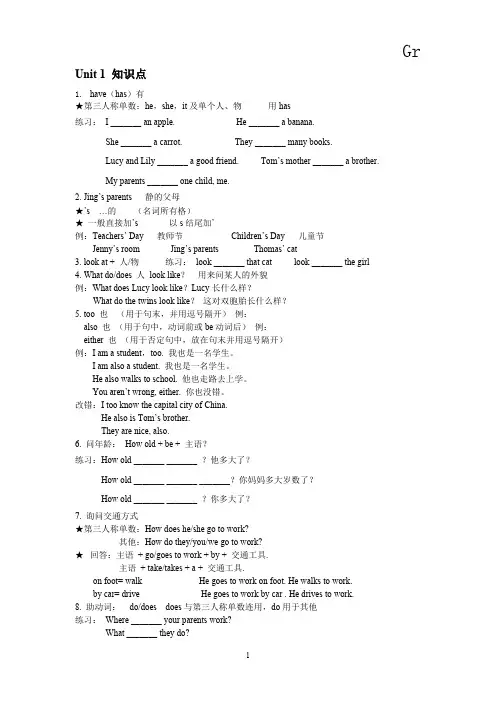
Gr Unit 1 知识点1.have(has)有★第三人称单数:he,she,it及单个人、物用has练习:I _______ an apple. He _______ a banana.She _______ a carrot. They _______ many books.Lucy and Lily _______ a good friend. Tom’s mother _______ a brother.My parents _______ one child, me.2. Jing’s parents 静的父母★’s …的(名词所有格)★一般直接加’s 以s结尾加’例:Teachers’ Day 教师节Children’s Day 儿童节Jenny’s room Jing’s parents Thomas’ cat3. look at + 人/物练习:look _______ that cat look _______ the girl4. What do/does 人look like?用来问某人的外貌例:What does Lucy look like?Lucy长什么样?What do the twins look like?这对双胞胎长什么样?5. too 也(用于句末,并用逗号隔开)例:also 也(用于句中,动词前或be动词后)例:either 也(用于否定句中,放在句末并用逗号隔开)例:I am a student,too. 我也是一名学生。
I am also a student. 我也是一名学生。
He also walks to school. 他也走路去上学。
You aren’t wrong, either. 你也没错。
改错:I too know the capital city of China.He also is Tom’s brother.They are nice, also.6. 问年龄:How old + be + 主语?练习:How old _______ _______ ?他多大了?How old _______ _______ _______?你妈妈多大岁数了?How old _______ _______ ?你多大了?7. 询问交通方式★第三人称单数:How does he/she go to work?其他:How do they/you/we go to work?★回答:主语+ go/goes to work + by + 交通工具.主语+ take/takes + a + 交通工具.on foot= walk He goes to work on foot. He walks to work.by car= drive He goes to work by car . He drives to work.8. 助动词:do/does does与第三人称单数连用,do用于其他练习:Where _______ your parents work?What _______ they do?GrWhere _______ your uncle do? How _______ he go to work?9. 人称代词人称代词人称主格宾格我I me 第一人称我们we us 第二人称你,你们you you 他he him 她she her 它it it 第三人称他们theythem练习:_______ are my little apple. (你) Please come with _______. (我) _______ is a boy.(他) _______ (她)teaches _______ (我们)English. _______ (你)can call _______ (她)Alice. _______(它) is a tiger.10. 询问某人喜欢做什么What do/does + 主语 + like to do ?What do/does + 主语 + like doing ?练习:What _______ you like to do?What _______ your father like to do?What _______ they like to do?What _______ the students like doing?What _______ Bob and Tom like doing?What _______ Tom like to do?Unit 2 知识点1.各国著名景点Tian’anmen Square 天安门广场 the Palace Museum 故宫博物馆the Great Wall 长城 Niagara Falls 尼加拉瓜瀑布CN Tower 加拿大电视塔 White House 白宫the Statue of Liberty 自由女神像 Big Ben 大本钟Buckingham Palace 白金汉宫 (专有名词首字母要大写)2. 复数变化:city – cities 城市leaf – leaves 叶子3. look “看,瞧” 强调看的动作 see “看” 强调看的结果watch “观看,注视” 强调动作(全神贯注的观看、观察或注视某事物的活动)watch TV watch a film/movie 4. 本单元词组a map of … 。
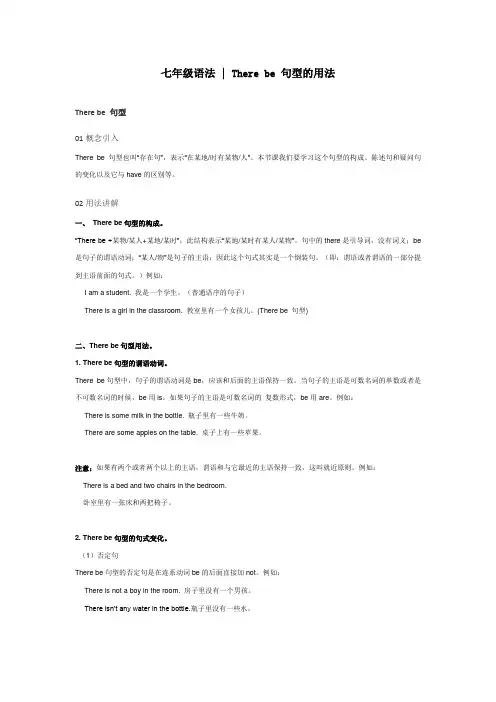
七年级语法 | There be 句型的用法There be 句型01概念引入There be 句型也叫“存在句”,表示“在某地/时有某物/人”。
本节课我们要学习这个句型的构成、陈述句和疑问句的变化以及它与have的区别等。
02用法讲解一、There be句型的构成。
“There be +某物/某人+某地/某时”;此结构表示“某地/某时有某人/某物”。
句中的there是引导词,没有词义;be 是句子的谓语动词;“某人/物”是句子的主语;因此这个句式其实是一个倒装句。
(即:谓语或者谓语的一部分提到主语前面的句式。
)例如:I am a student. 我是一个学生。
(普通语序的句子)There is a girl in the classroom. 教室里有一个女孩儿。
(There be 句型)二、There be句型用法。
1. There be句型的谓语动词。
There be句型中,句子的谓语动词是be,应该和后面的主语保持一致。
当句子的主语是可数名词的单数或者是不可数名词的时候,be用is;如果句子的主语是可数名词的复数形式,be用are。
例如:There is some milk in the bottle. 瓶子里有一些牛奶。
There are some apples on the table. 桌子上有一些苹果。
注意:如果有两个或者两个以上的主语,谓语和与它最近的主语保持一致,这叫就近原则。
例如:There is a bed and two chairs in the bedroom.卧室里有一张床和两把椅子。
2. There be句型的句式变化。
(1)否定句There be句型的否定句是在连系动词be的后面直接加not。
例如:There is not a boy in the room. 房子里没有一个男孩。
There isn’t any water in the bottle.瓶子里没有一些水。
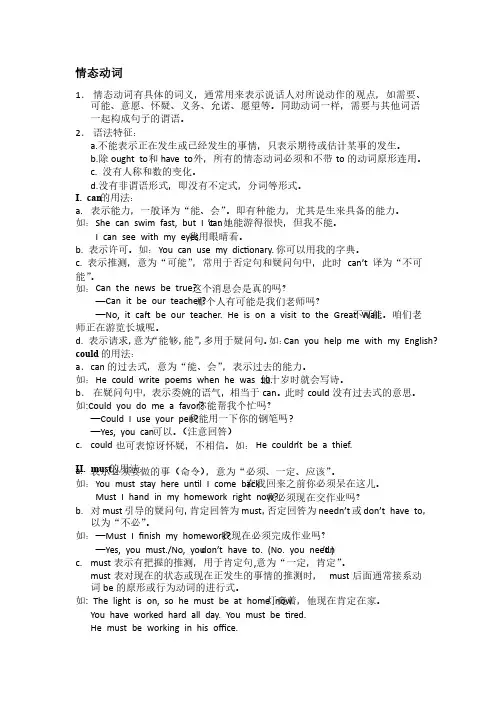
情态动词1. 情态动词有具体的词义,通常用来表示说话人对所说动作的观点,如需要、可能、意愿、怀疑、义务、允诺、愿望等。
同助动词一样,需要与其他词语一起构成句子的谓语。
一起构成句子的谓语。
2. 语法特征:语法特征:a.不能表示正在发生或已经发生的事情,只表示期待或估计某事的发生。
b.除ought to 和have to 外,所有的情态动词必须和不带to 的动词原形连用。
c. 没有人称和数的变化。
没有人称和数的变化。
d.没有非谓语形式,即没有不定式,分词等形式。
I. can 的用法:的用法:a. 表示能力,一般译为“能、会”。
即有种能力,尤其是生来具备的能力。
如:She can swim fast, but I can ’t . 她能游得很快,但我不能。
她能游得很快,但我不能。
I can see with my eyes.我用眼睛看。
我用眼睛看。
b. 表示许可。
如:You can use my dic onary. 你可以用我的字典。
你可以用我的字典。
c. 表示推测,意为“可能”,常用于否定句和疑问句中,此时can can’’t 译为“不可能”。
如:Can the news be true? 这个消息会是真的吗?这个消息会是真的吗?—Can it be our teacher?那个人有可能是我们老师吗?那个人有可能是我们老师吗?—No, it can ’t be our teacher. He is on a visit to the Great Wall.不可能。
咱们老师正在游览长城呢。
师正在游览长城呢。
d. 表示请求,意为“能够,能”,多用于疑问句。
如:Can you help me with my English? could 的用法:的用法:a . c an 的过去式,意为“能、会”,表示过去的能力。
,表示过去的能力。
如:He could write poems when he was 10. 他十岁时就会写诗。
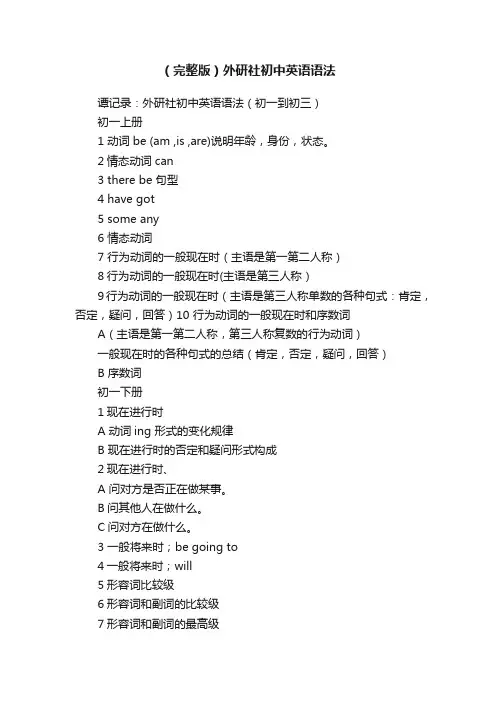
(完整版)外研社初中英语语法谭记录:外研社初中英语语法(初一到初三)初一上册1 动词be (am ,is ,are)说明年龄,身份,状态。
2情态动词can3 there be 句型4 have got5 some any6 情态动词7 行为动词的一般现在时(主语是第一第二人称)8行为动词的一般现在时(主语是第三人称)9行为动词的一般现在时(主语是第三人称单数的各种句式:肯定,否定,疑问,回答)10 行为动词的一般现在时和序数词A(主语是第一第二人称,第三人称复数的行为动词)一般现在时的各种句式的总结(肯定,否定,疑问,回答)B 序数词初一下册1现在进行时A 动词ing 形式的变化规律B 现在进行时的否定和疑问形式构成2现在进行时、A 问对方是否正在做某事。
B问其他人在做什么。
C问对方在做什么。
3 一般将来时;be going to4一般将来时;will5形容词比较级6形容词和副词的比较级7形容词和副词的最高级8一般过去时(肯定,否定,疑问,回答)9一般过去时(构成和否定形式)10一般过去时(肯定,否定,疑问,回答)11一般过去时的特殊疑问形式。
12 一般过去时(不规则动词的变化形式)初二上册1 一般现在时,一般过去时,一般将来时,现在进行时2现在完成时(结构)3现在完成时(概念)4现在完成时(与一般过去时的区别)5 反义疑问句6过去进行时。
7表感觉和知觉的系动词8 方位的表达方式(介词表达方位)9动词不定式的语法功能。
10 动词不定式和双宾语。
11 情态动词may /might12 情态动词must ,can初二下册1 五种基本句型2 宾语从句(whether,if引导的从句,疑问词引导的宾语从句)3 不定式和动名词做宾语。
4 if 从句(构成与位置)5 if 从句(if 从句中,一般现在时表示未来的条件)6 直接引语和间接引语。
(陈述句的转述)7直接引语和间接引语。
(祈使句的转述,一般,特殊疑问句的转述,表示客观真理时,原来的时态不变。
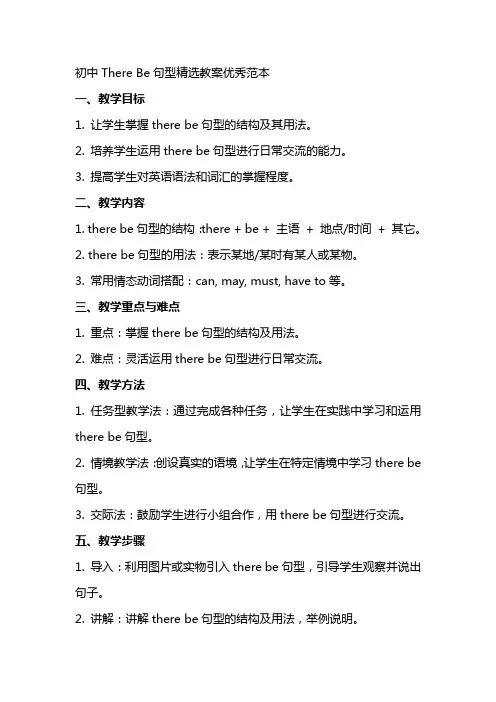
初中There Be句型精选教案优秀范本一、教学目标1. 让学生掌握there be句型的结构及其用法。
2. 培养学生运用there be句型进行日常交流的能力。
3. 提高学生对英语语法和词汇的掌握程度。
二、教学内容1. there be句型的结构:there + be + 主语+ 地点/时间+ 其它。
2. there be句型的用法:表示某地/某时有某人或某物。
3. 常用情态动词搭配:can, may, must, have to等。
三、教学重点与难点1. 重点:掌握there be句型的结构及用法。
2. 难点:灵活运用there be句型进行日常交流。
四、教学方法1. 任务型教学法:通过完成各种任务,让学生在实践中学习和运用there be句型。
2. 情境教学法:创设真实的语境,让学生在特定情境中学习there be 句型。
3. 交际法:鼓励学生进行小组合作,用there be句型进行交流。
五、教学步骤1. 导入:利用图片或实物引入there be句型,引导学生观察并说出句子。
2. 讲解:讲解there be句型的结构及用法,举例说明。
3. 练习:让学生进行there be句型的填空练习,巩固知识点。
4. 小组活动:学生分组,用there be句型描述图片或实物,进行交流。
5. 总结:对本节课的内容进行总结,强调there be句型的用法。
6. 作业布置:让学生课后用there be句型写一篇小短文,描述自己的房间或学校。
7. 课后反馈:收集学生的作业,对学生的学习情况进行评价和反馈。
六、教学拓展1. 引导学生学习其他情态动词与there be句型的搭配,如:must, can, may等。
2. 举例说明there be句型在实际生活中的应用,如购物、问路等场景。
七、课堂互动1. 采用问答方式,让学生练习使用there be句型。
2. 组织小组竞赛,看哪个小组用there be句型描述得最准确、最生动。
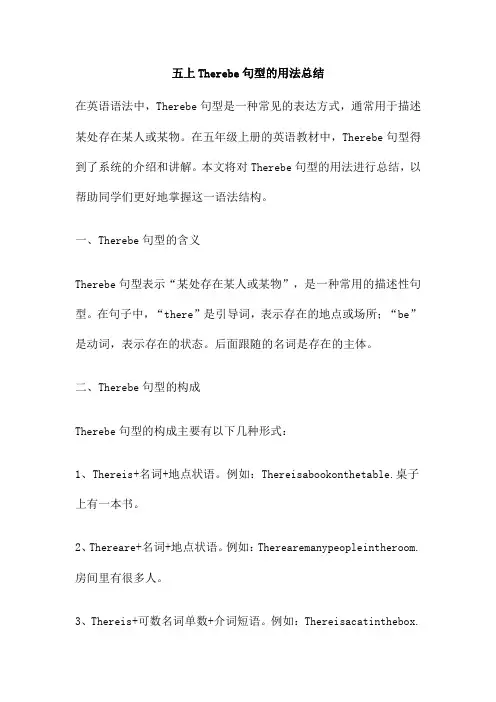
五上Therebe句型的用法总结在英语语法中,Therebe句型是一种常见的表达方式,通常用于描述某处存在某人或某物。
在五年级上册的英语教材中,Therebe句型得到了系统的介绍和讲解。
本文将对Therebe句型的用法进行总结,以帮助同学们更好地掌握这一语法结构。
一、Therebe句型的含义Therebe句型表示“某处存在某人或某物”,是一种常用的描述性句型。
在句子中,“there”是引导词,表示存在的地点或场所;“be”是动词,表示存在的状态。
后面跟随的名词是存在的主体。
二、Therebe句型的构成Therebe句型的构成主要有以下几种形式:1、Thereis+名词+地点状语。
例如:Thereisabookonthetable.桌子上有一本书。
2、Thereare+名词+地点状语。
例如:Therearemanypeopleintheroom.房间里有很多人。
3、Thereis+可数名词单数+介词短语。
例如:Thereisacatinthebox.盒子里有一只猫。
4、Thereare+可数名词复数+介词短语。
例如:Therearethreecatsinthebox.盒子里有三只猫。
5、Thereis+不可数名词+介词短语。
例如:Thereiswaterintheglass.杯子里有水。
6、Thereare+不可数名词+介词短语。
例如:Thereare twocups of coffee on the table.桌子上有两杯咖啡。
三、Therebe句型的用法1、表示存在:Therebe句型可以用来描述某处存在某人或某物,例如:Thereis a book on the table.桌子上有一本书。
2、表示数量:Therebe句型可以通过数量词和可数名词的单复数形式来表达数量的概念,例如:There are three apples in the bag.袋子里有三个苹果。
3、表示位置:Therebe句型可以用来描述某人或某物的位置,例如:There is a lamp on the desk.桌子上有一盏灯。
There Be 句型的语法教案一、教学目标:1. 让学生理解并掌握there be 句型的结构、用法和意义。
2. 培养学生运用there be 句型进行日常交流的能力。
3. 提高学生对英语语法的学习兴趣。
二、教学内容:1. There be 句型的结构:there + be + 主语+ 地点/时间+ 表语。
2. There be 句型的用法和意义:表示某个地方或时间内存在某人或某物。
3. There be 句型的注意事项:a) 根据就近原则确定谓语动词的人称和数。
b) there be 句型中不能出现助动词或情态动词。
c) there be 句型可以用缩写形式。
三、教学重点和难点:1. 教学重点:there be 句型的结构、用法和意义。
2. 教学难点:根据就近原则确定谓语动词的人称和数,以及there be 句型的注意事项。
四、教学方法:1. 任务型教学法:通过小组活动、角色扮演等形式,让学生在实际语境中运用there be 句型。
2. 交际型教学法:引导学生进行pr work、group work 等活动,提高学生的口语表达能力。
3. 语法讲解与练习相结合:通过讲解例句、演练练习题,帮助学生巩固所学知识。
五、教学步骤:1. 引入:向学生介绍there be 句型的结构、用法和意义。
2. 讲解:通过例句讲解there be 句型的注意事项,如就近原则、谓语动词的人称和数等。
3. 练习:设计不同场景的练习题,让学生运用there be 句型进行描述。
4. 互动:组织小组活动或角色扮演,让学生在实际语境中运用there be 句型。
5. 总结:对本节课所学内容进行总结,强调there be 句型的结构和用法。
教学评价:通过课堂表现、练习题和小组活动,评价学生对there be 句型的掌握程度。
六、教学活动设计:1. 情境模拟:设计一个机场接机的情境,让学生用there be 句型描述机场内的各种设施和人物。
therebe句型(教案)There be 句型一. There be 句型常用来表示某地/某时有某物/某人二. 各种句型结构1.肯定句:There+be (is/are)+某物/某人+地点/时间。
There is a computer in the room. 房间里有一台电脑。
There are two TV plays every evening. 每晚有两场电视剧2.否定句:There+be(is/are)+not+某物/某人+地点/时间。
这个句式的否定形式的构成是将be之后加not,同时,原句中如有some一词,也应改为any. 例如:There isn't any bird in the tree./There is no bird in the tree.树上没有鸟。
There aren't any children behind the house./There are no children behind the house房后没有小孩。
3. 一般疑问句:Be(Is/Are)+there+某物/某人+地点/时间?Are there any birds in the picture? 图画中有鸟吗?对疑问句的应答:Yes, there are./ there aren't.4. 特殊疑问句:特殊疑问词+be(is/are)+there+其它?How many birds are there in the picture?图片中有多少只小鸟?There is only one.仅有一只。
针对主语提问的特殊疑问句的基本结构是:What’s + 介词短语?What’s on the boat?5.There be 句型的反意疑问句There is a cup on the table, isn’t there?桌子上有只杯子,是吗?There are a lot of letters in the mailbox, aren’t there?邮筒里有很多信件,是吗?There will be a new hospital nearby, won’t there?附近要建一家新医院,是吗?三.主谓一致There be后面所接的某物有多个时,谓语动词be要根据最靠近它的那个名词的单复数来确定,即就近原则。
英语Therebe句型的用法大全一、基本用法There be 句型是英语中最为常用的句型之一,主要用来表示“人或事物的存在”或“某地有某物”。
There在此结构中是引导词,已经没有副词“那里”的含义。
be 后的名词是句子的主语。
其基本用法结构为:•There be+名词主语(人或物)+地点其中,be的形式随着后面的名词时单数还是复数而变化,即:当be后面接的是单数可数名词,则采用is;当be后面接的是复数可数名词,则采用are。
如:•There is a man under the tree.•There are some apples on the table.【注意】1、否定句There be的否定句一般是直接在be后加not,not可以缩略为't。
如果原句中还有some,一般要改为any。
如:•There isn't a man under the tree.•There aren't any apples on the table.还有一种否定表达方式是通过no来表达,此时的no相当于not...any。
如:•There is no water in the bottle.•There isn't any water in the bottle.•There are no pictures on the wall.•There aren't any pictures on the wall.2、一般疑问句There be句型要改为一般疑问句,只要把be提到句首即可。
其肯定回答为:Yes, there is/are,否定回答为:No, there isn't/aren't。
如果原句中含有some,也要改为any。
如:- Is there a man under the tree?- Yes, there is. / No, there isn't.- Are there any apples on the table?- Yes, there are. / No, there aren't.3、特殊疑问句There be 句型的特殊疑问句主要有how many和how much做引导词两种情况。
have got句型用法详解表示某地有某人/某物,我们用“there be ”句型,而表示某人有某物,可以用have/has got句型,它表示某物归某人所有,是一种所属关系,主语为人。
一、常见句式:1、否定句:在Have或Has后加not,缩写为haven’t或hasn’t.I have got a dog.I have not got a dog.2、疑问句:把have或has提前,注意首字母需要大写。
We have got a brother.Have we got a brother?回答为: 肯定Yes,we have.否定No,we haven’t.二、与have/has的互相转换:转换:have got=have has got=has1、在只含有have的句子中,变否定句在have前加don’t,其余不变.变疑问句在句首加Do,其余不变.I have a bike.=I have got a bike.否定句:I don’t have a bike.=I haven’t got a bike.疑问句:Do you have a bike?=Have you got a bike?2、在只含有has的句子中,变否定句在has前加doesn’t,has变成have.变疑问句在句首加Does,has变成have.He has a lot of friends. = He has got a lot of friends.否定句:He doesn’t have a lot of friends. = He hasn’t got a lot of friends.疑问句:Dose he have a lot of friends? = Has he got a lot of friends?三、在下列情况下不能用have got来代替have。
1. 在情态动词,助动词或动词不定式之后,只能用have,不用have got。
There be 句型与have, has
1、There be 句型表示:在某地有某物(或人)
2、在there be 句型中,主语是单数,be 动词用is ; 主语是复数,be 动词用are ; 如有几件物品,be 动词根据最近be 动词的那个名词决定。
3、there be 句型的否定句在be 动词后加not , 一般疑问句把be 动词调到句首。
4、there be句型与have(has) 的区别:there be 表示在某地有某物(或人);have(has) 表示某人拥有某物。
5、some 和any 在there be 句型中的运用:some 用于肯定句,any 用于否定句或疑问句。
6、and 和or 在there be句型中的运用:and 用于肯定句,or 用于否定句或疑问句。
7、针对数量提问的特殊疑问句的基本结构是:How many + 名词复数+ are there + 介词短语?How much + 不可数名词+ is there + 介词短语?
如:How many apples are there on the desk?
How much water is there in your shop?
8、针对主语提问的特殊疑问句的基本结构是:What’s + 介词短语?
如:What’ on the desk?
用“have,has”或“there is , there are”填空
1. I________a good father and a good mother.
2. ____________a telescope on the desk.
3. He_________a toy.
4. _____________a basketball in the playground.
5. She__________some dresses.
6. They___________a nice garden.
7. What do you___________?
8. ______________a reading-room in the building?
9. What does Mike___________?
10. ______________any books in the bookcase?
11. My father_________a story-book.
12. _______________a story-book on the table.
13. _______________any flowers in the vase?
14. How many students____________in the classroom?
15. My parents___________some nice pictures.
16. _____________some maps on the wall.
17. ______________a map of the world on the wall.
18. David__________a telescope.
19. David’s friends___________some tents.
20. ______________many children on the hill.
用“ have, has ”填空
1. I_________ a red car.
2. He_________a good friend.
3. They__________ some masks.
4. We___________some flowers.
5. She___________ a duck.
6. My father____________ a new bike.
7. Her mother___________a vase.
8. Our teacher_________ an English book.
9. Our teachers___________a basketball.
10. Their parents___________some blankets
11. Nancy_________many skirts.
12. David__________some jackets.
13. My friends__________a football.
14. What do you__________?
15. What does Mike__________?
16. What do your friends___________?
17. What does Helen___________?
18. His brother________a basketball.
19. Her sister_________a nice doll.
20. Miss Li__________an English book.
对划线部分提问:
There are three books in Tom’s bag.
I have three books .
There are three books in Tom’s bag.
I have three books .
can情态动词
陈述句:主语+can+V原+其他I can play football.
否定句:主语+can+not+V原+其他I can’t play football. can’t=can not
一般疑问句:Can+主语+ V原+其他?Can he play football?Yes,he can./No,he can’t. 特殊疑问句:What can+主语+V原?What can you do?
翻译句子:
TOM会唱歌。
Mike 不会打篮球。
你能听到什么?
我能帮你什么吗?
Lily会跳舞吗?。